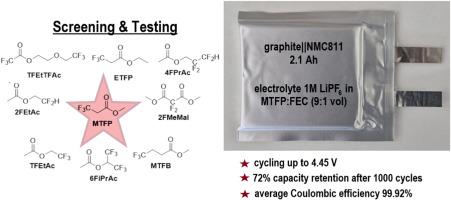Enhancing lithium-ion battery performance through a multi-benefit fluorinated electrolyte
IF 7.9
2区 工程技术
Q1 CHEMISTRY, PHYSICAL
引用次数: 0
Abstract
Advanced electrolytes are essential for extending the operational voltage and cycle life of lithium-ion batteries (LIBs) to meet the demands of high-energy applications and enhance safety. Here, we report the design and development of a non-flammable 1M LiPF6 electrolyte based on methyl 3,3,3-trifluoropropionate (MTFP) and fluoroethylene carbonate (FEC). This electrolyte enables stable cycling of high-voltage graphite||NMC811 LIBs up to 4.5 V, thereby significantly exceeding the voltage limits of conventional carbonate-based electrolytes. Commercial-scale 2.1 Ah pouch cells with a high active material loading (3.8 mA h/cm2) retain 72 % of their initial capacity for over 1000 cycles at 0.5C (2.7–4.45 V). This enhanced performance and cycling stability are attributed to the formation of a protective LiF passivation layer on both the cathode and anode surfaces, as revealed by X-ray photoelectron spectroscopy. These findings highlight the viability of MTFP-based electrolytes for next-generation LIBs with higher energy density and extended cycle life.

通过多效氟化电解质提高锂离子电池性能
先进的电解质对于延长锂离子电池(lib)的工作电压和循环寿命,以满足高能量应用和提高安全性的要求至关重要。在这里,我们报道了基于3,3,3-三氟丙酸甲酯(MTFP)和氟碳酸乙烯(FEC)的不可燃1M LiPF6电解质的设计和开发。这种电解质可以使高压石墨||NMC811锂电池稳定循环至4.5 V,从而大大超过传统碳酸盐基电解质的电压极限。商业规模的2.1 Ah袋电池具有高活性材料负载(3.8 mA h/cm2),在0.5C (2.7-4.45 V)下保持超过1000次循环的72%的初始容量。x射线光电子能谱显示,这种增强的性能和循环稳定性归因于阴极和阳极表面形成的保护性锂离子钝化层。这些发现强调了基于mtfp的电解质用于下一代锂离子电池的可行性,具有更高的能量密度和更长的循环寿命。
本文章由计算机程序翻译,如有差异,请以英文原文为准。
求助全文
约1分钟内获得全文
求助全文
来源期刊

Journal of Power Sources
工程技术-电化学
CiteScore
16.40
自引率
6.50%
发文量
1249
审稿时长
36 days
期刊介绍:
The Journal of Power Sources is a publication catering to researchers and technologists interested in various aspects of the science, technology, and applications of electrochemical power sources. It covers original research and reviews on primary and secondary batteries, fuel cells, supercapacitors, and photo-electrochemical cells.
Topics considered include the research, development and applications of nanomaterials and novel componentry for these devices. Examples of applications of these electrochemical power sources include:
• Portable electronics
• Electric and Hybrid Electric Vehicles
• Uninterruptible Power Supply (UPS) systems
• Storage of renewable energy
• Satellites and deep space probes
• Boats and ships, drones and aircrafts
• Wearable energy storage systems
 求助内容:
求助内容: 应助结果提醒方式:
应助结果提醒方式:


